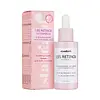What's inside
What's inside
 Key Ingredients
Key Ingredients

 Benefits
Benefits

 Concerns
Concerns

 Ingredients Side-by-side
Ingredients Side-by-side

Water
Skin ConditioningPropanediol
SolventDimethicone
EmollientCetearyl Ethylhexanoate
EmollientAlcohol Denat.
AntimicrobialAllyl Methacrylates Crosspolymer
Emulsion StabilisingDipropylene Glycol
HumectantAmmonium Polyacryloyldimethyl Taurate
Emulsion StabilisingAcrylamide/Sodium Acryloyldimethyltaurate Copolymer
Emulsion StabilisingRetinol
Skin ConditioningHydrogenated Lecithin
EmulsifyingPolysorbate 20
EmulsifyingIsohexadecane
EmollientPhenoxyethanol
PreservativeCaprylyl Glycol
EmollientIsopropyl Myristate
EmollientSodium Citrate
BufferingBoswellia Serrata Gum
MaskingPolysorbate 80
EmulsifyingBHT
AntioxidantDimethiconol
EmollientTrisodium Ethylenediamine Disuccinate
Bisabolol
MaskingSorbitan Oleate
EmulsifyingCitric Acid
BufferingPropyl Gallate
AntioxidantWater, Propanediol, Dimethicone, Cetearyl Ethylhexanoate, Alcohol Denat., Allyl Methacrylates Crosspolymer, Dipropylene Glycol, Ammonium Polyacryloyldimethyl Taurate, Acrylamide/Sodium Acryloyldimethyltaurate Copolymer, Retinol, Hydrogenated Lecithin, Polysorbate 20, Isohexadecane, Phenoxyethanol, Caprylyl Glycol, Isopropyl Myristate, Sodium Citrate, Boswellia Serrata Gum, Polysorbate 80, BHT, Dimethiconol, Trisodium Ethylenediamine Disuccinate, Bisabolol, Sorbitan Oleate, Citric Acid, Propyl Gallate
Ingredients Explained
These ingredients are found in both products.
Ingredients higher up in an ingredient list are typically present in a larger amount.
Citric Acid is an alpha hydroxy acid (AHA) naturally found in citrus fruits like oranges, lemons, and limes.
Like other AHAs, citric acid can exfoliate skin by breaking down the bonds that hold dead skin cells together. This helps reveal smoother and brighter skin underneath.
However, this exfoliating effect only happens at high concentrations (20%) which can be hard to find in cosmetic products.
Due to this, citric acid is usually included in small amounts as a pH adjuster. This helps keep products slightly more acidic and compatible with skin's natural pH.
In skincare formulas, citric acid can:
While it can provide some skin benefits, research shows lactic acid and glycolic acid are generally more effective and less irritating exfoliants.
Most citric acid used in skincare today is made by fermenting sugars (usually from molasses). This synthetic version is identical to the natural citrus form but easier to stabilize and use in formulations.
Read more about some other popular AHA's here:
Learn more about Citric AcidPhenoxyethanol is a preservative that has germicide, antimicrobial, and aromatic properties. Studies show that phenoxyethanol can prevent microbial growth. By itself, it has a scent that is similar to that of a rose.
It's often used in formulations along with Caprylyl Glycol to preserve the shelf life of products.
Polysorbate 80 is a surfactant and emulsifier. It is used to keep ingredients together, and prevent oils and waters from separating.
It is made from polyethoxylated sorbitan and oleic acid. This ingredient can be found in cosmetics, foods, and medicine. It is water-soluble.
Polysorbate 80 may not be fungal acne safe.
Learn more about Polysorbate 80Water. It's the most common cosmetic ingredient of all. You'll usually see it at the top of ingredient lists, meaning that it makes up the largest part of the product.
So why is it so popular? Water most often acts as a solvent - this means that it helps dissolve other ingredients into the formulation.
You'll also recognize water as that liquid we all need to stay alive. If you see this, drink a glass of water. Stay hydrated!
Learn more about Water